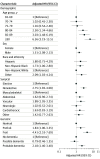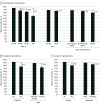Population-Based Estimates of 1-Year Mortality After Major Surgery Among Community-Living Older US Adults
- PMID: 36260323
- PMCID: PMC9582971
- DOI: 10.1001/jamasurg.2022.5155
Population-Based Estimates of 1-Year Mortality After Major Surgery Among Community-Living Older US Adults
Erratum in
-
Errors in Figure 4.JAMA Surg. 2023 Mar 1;158(3):331. doi: 10.1001/jamasurg.2022.8077. JAMA Surg. 2023. PMID: 36696129 Free PMC article. No abstract available.
Abstract
Importance: Despite their importance to guiding public health decision-making and policies and to establishing programs aimed at improving surgical care, contemporary nationally representative mortality data for geriatric surgery are lacking.
Objective: To calculate population-based estimates of mortality after major surgery in community-living older US adults and to determine how these estimates differ according to key demographic, surgical, and geriatric characteristics.
Design, setting, and participants: Prospective longitudinal cohort study with 1 year of follow-up in the continental US from 2011 to 2018. Participants included 5590 community-living fee-for-service Medicare beneficiaries, aged 65 years or older, from the National Health and Aging Trends Study (NHATS). Data analysis was conducted from February 22, 2021, to March 16, 2022.
Main outcomes and measures: Major surgeries and mortality over 1 year were identified through linkages with data from the Centers for Medicare & Medicaid Services. Data on frailty and dementia were obtained from the annual NHATS assessments.
Results: From 2011 to 2017, of the 1193 major surgeries (from 992 community-living participants), the mean (SD) age was 79.2 (7.1) years; 665 were women (55.7%), and 30 were Hispanic (2.5%), 198 non-Hispanic Black (16.6%), and 915 non-Hispanic White (76.7%). Over the 1-year follow-up period, there were 206 deaths representing 872 096 survey-weighted deaths and 13.4% (95% CI, 10.9%-15.9%) mortality. Mortality rates were 7.4% (95% CI, 4.9%-9.9%) for elective surgeries and 22.3% (95% CI, 17.4%-27.1%) for nonelective surgeries. For geriatric subgroups, 1-year mortality was 6.0% (95% CI, 2.6%-9.4%) for persons who were nonfrail, 27.8% (95% CI, 21.2%-34.3%) for those who were frail, 11.6% (95% CI, 8.8%-14.4%) for persons without dementia, and 32.7% (95% CI, 24.3%-41.0%) for those with probable dementia. The age- and sex-adjusted hazard ratios for 1-year mortality were 4.41 (95% CI, 2.53-7.69) for frailty with a reduction in restricted mean survival time of 48.8 days and 2.18 (95% CI, 1.40-3.40) for probable dementia with a reduction in restricted mean survival time of 44.9 days.
Conclusions and relevance: In this study, the population-based estimate of 1-year mortality after major surgery among community-living older adults in the US was 13.4% but was 3-fold higher for nonelective than elective procedures. Mortality was considerably elevated among older persons who were frail or who had probable dementia, highlighting the potential prognostic value of geriatric conditions after major surgery.
Conflict of interest statement
Figures




Comment in
-
Patient Experience Following Surgery in the Geriatric Population-Increased Relevance and Importance of Longer-Term Surgical Outcomes.JAMA Surg. 2022 Dec 1;157(12):e225156. doi: 10.1001/jamasurg.2022.5156. Epub 2022 Dec 14. JAMA Surg. 2022. PMID: 36260347 No abstract available.
-
Interaction Between Frailty and Dementia.JAMA Surg. 2023 Aug 1;158(8):888-889. doi: 10.1001/jamasurg.2023.0378. JAMA Surg. 2023. PMID: 37017961 No abstract available.
-
Interaction Between Frailty and Dementia-Reply.JAMA Surg. 2023 Aug 1;158(8):889. doi: 10.1001/jamasurg.2023.0381. JAMA Surg. 2023. PMID: 37017979 No abstract available.
References
-
- Mather M, Jacobsen LA, Pollard KM. Fact sheet: aging in the United States. Population Bulletin. July 15, 2019. Accessed September 13, 2022. https://www.prb.org/resources/fact-sheet-aging-in-the-united-states/
-
- United States Census Bureau . Older people projected to outnumber children for first time in US history. March 13, 2018. Accessed September 13, 2022. https://www.census.gov/newsroom/press-releases/2018/cb18-41-population-p....
Publication types
MeSH terms
Grants and funding
LinkOut - more resources
Full Text Sources
Medical

